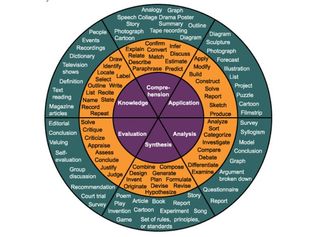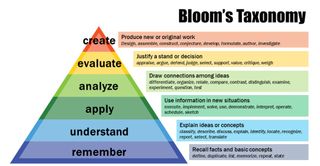Benjamin Bloom was not a lone duck. He collaborated with Max Englehart, Edward Furst, Walter Hill, and David Krathwohl to publish a framework for categorizing educational goals in 1956 named Taxonomy of Educational Objectives. Over time, this pyramid became known as Bloom’s Taxonomy and has been used for generations of teachers and university professors.
The framework consisted of six major categories: Knowledge, Comprehension, Application, Analysis, Synthesis, and Evaluation. The creative commons image of 1956 Blooms includes verbs used to describe the action taking place within each category of the taxonomy.

In 1997, a new method entered the scene to help teachers in recognition of a student’s understanding. Based on his study, Dr. Norman Webb established a Depth of Knowledge model to categorize activities according to the level of complexity in thinking and stemmed from the standards movement alignment. This model involves the analysis of the cognitive expectation demanded by standards, curricular activities, and assessment tasks (Webb, 1997).
In 2001, a group of cognitive psychologists, curriculum theorists, instructional researchers, and testing and assessment specialists joined forces to publish A Taxonomy for Teaching, Learning, and Assessment, a revised version of Bloom's Taxonomy. Action words to describe the cognitive processes thinkers encounter with knowledge were incorporated, rather than the nouns that were used as descriptors for the original categories.

In this new Bloom’s Taxonomy, knowledge is the basis of the six cognitive processes: remember, understand, apply, analyze, evaluate, and create. The authors of the new framework also identified different types of knowledge used in cognition: factual knowledge, conceptual knowledge, procedural knowledge, and metacognitive knowledge. The lower-order thinking skills remain at the base of the pyramid with the higher-order skills at the pinnacle. To learn more about the new Bloom’s, check out this guide to the revised revision.
The use of technology has been integrated into the model, creating what is now known as Bloom’s Digital Taxonomy. A popular image that districts often create is the pyramid with the digital resources available and promoted in the district aligned with the appropriate category. This image would vary depending on district resources but it is very helpful to create something such as this for teachers to connect technology to the levels of Bloom’s.

Beyond Bloom’s, teachers have access to a variety of frameworks and tools to help them construct technology-rich learning. The University of South Florida probably has one of the most robust resources through its Technology Integration Matrix. The original TIM was developed in 2003-06 through funding from the Enhancing Education Through Technology program. Now in the third edition, the TIM provides not only a matrix from low to high adoption and student engagement but also videos and lesson design ideas accessible for free to all educators.
Each of these frameworks, models, and matrices help guide teachers in designing instruction that is beneficial and engaging to their learners. Now more than ever, the focus on high-quality technology-rich instruction is essential for increased student engagement and improved student performance.
Get the latest edtech news delivered to your inbox here:


